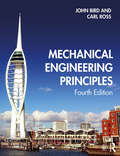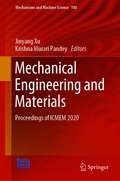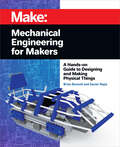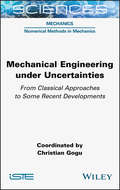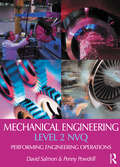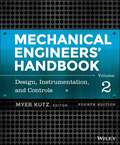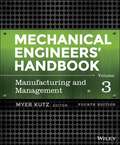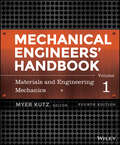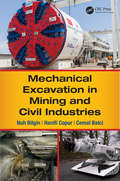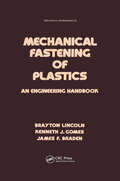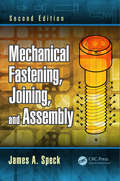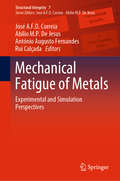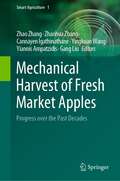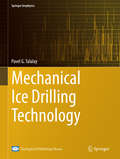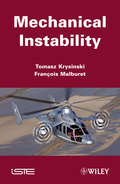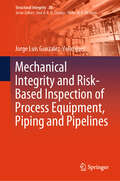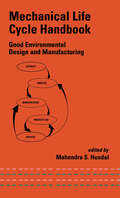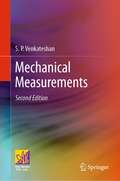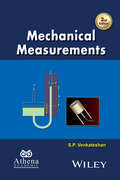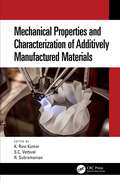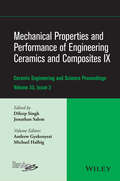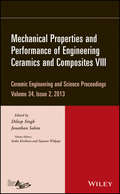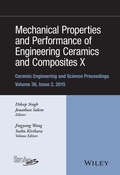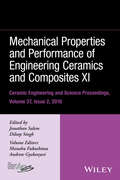- Table View
- List View
Mechanical Engineering Principles, 3rd ed
by John Bird Carl RossA student-friendly introduction to core engineering topics This book introduces mechanical principles and technology through examples and applications, enabling students to develop a sound understanding of both engineering principles and their use in practice. These theoretical concepts are supported by 400 fully worked problems, 700 further problems with answers, and 300 multiple-choice questions, all of which add up to give the reader a firm grounding on each topic. The new edition is up to date with the latest BTEC National specifications and can also be used on undergraduate courses in mechanical, civil, structural, aeronautical and marine engineering, together with naval architecture. A further chapter has been added on revisionary mathematics, since progress in engineering studies is not possible without some basic mathematics knowledge. Further worked problems have also been added throughout the text. New chapter on revisionary mathematics Student-friendly approach with numerous worked problems, multiple-choice and short-answer questions, exercises, revision tests and nearly 400 diagrams Supported with free online material for students and lecturers Readers will also be able to access the free companion website at: www.routledge.com/cw/bird where they will find videos of practical demonstrations by Carl Ross. Full worked solutions of all 700 of the further problems will be available for both lecturers and students for the first time.
Mechanical Engineering Principles, 4th ed
by John Bird Carl RossA student-friendly introduction to core mechanical engineering topics. This book introduces mechanical principles and technology through examples and applications, enabling students to develop a sound understanding of both engineering principles and their use in practice. These theoretical concepts are supported by 400 fully worked problems, 700 further problems with answers, and 300 multiple-choice questions, all of which add up to give the reader a firm grounding on each topic. Two new chapters are included, covering the basic principles of matrix algebra and the matrix displacement method. The latter will also include guidance on software that can be used via SmartPhones, tablets or laptops. The new edition is up to date with the latest BTEC National specifications and can also be used on undergraduate courses in mechanical, civil, structural, aeronautical and marine engineering, and naval architecture. A companion website contains the fully worked solutions to the problems and revision tests, practical demonstration videos, as well as a glossary and information on the famous engineers mentioned in the text.
Mechanical Engineering and Materials: Proceedings of ICMEM 2020 (Mechanisms and Machine Science #100)
by Jinyang Xu Krishna Murari PandeyThis book gathers the latest advances, innovations, and applications in the field of mechanical engineering, as presented by leading international researchers and engineers at the 2020 International Conference on Mechanical Engineering and Materials (ICMEM), held in Beijing, China on October 16-17, 2020. ICMEM covers all aspects of mechanical engineering and material sciences, such as computer-aided design, virtual design and design visualization, intelligent design, usability design, automobile structure, human-machine interface design, manufacturing engineering, aerospace engineering, automation and robotics, micro-machining, MEMS/ NEMS, composite materials, biomaterials, smart materials, superconducting materials, materials properties and applications, materials manufacturing, nanotechnology, nano-materials and nano-composites, etc. The contributions, which were selected by means of a rigorous international peer-review process, highlight numerous exciting ideas that will spur novel research directions and foster multidisciplinary collaborations.
Mechanical Engineering for Makers: A Hands-on Guide to Designing and Making Physical Things
by Brian Bunnell Samer NajiaThis practical, user-friendly reference book of common mechanical engineering concepts is geared toward makers who don't have (or want) an engineering degree but need to know the essentials of basic mechanical elements to successfully accomplish their personal projects. The book provides practical mechanical engineering information (supplemented with the applicable math, science, physics, and engineering theory) without being boring like a typical textbook. Most chapters contain at least one hands-on, fully illustrated, step-by-step project to demonstrate the topic being discussed and requires only common, inexpensive, easily sourced materials and tools. Some projects also provide alternative materials and tools and processes to align with the reader's individual preferences, skills, tools, and materials-at-hand. Linked together via the authors' overarching project -- building a kid-sized tank -- the chapters describe the thinking behind each mechanism and then expands the discussions to similar mechanical concepts in other applications. Written with humor, a bit of irreverence, and entertaining personal insights and first-hand experiences, the book presents complex concepts in an uncomplicated way.Highlights include:Provides mechanical engineering information that includes math, science, physics and engineering theory without being a textbookContains hands-on projects in each chapter that require common, inexpensive, easily sourced materials and toolsAll hands-on projects are fully illustrated with step-by-step instructionsSome hands-on projects provide alternative materials and tools/processes to align with the reader's individual preferences, skills, tools and materials-at-handIncludes real-world insights from the authors like tips and tricks ("Staying on Track") and fail moments ("Lost Track!")Many chapters contain a section ("Tracking Further") that dives deeper into the chapter subject, for those readers that are interested in more details of the topicBuilds on two related Make: projects to link and illustrate all the chapter topics and bring individual concepts together into one systemFurnishes an accompanying website that offers further information, illustrations, projects, discussion boards, videos, animations, patterns, drawings, etc.Learn to effectively use professional mechanical engineering principles in your projects, without having to graduate from engineering school!
Mechanical Engineering in Uncertainties From Classical Approaches to Some Recent Developments: From Classical Approaches To Some Recent Developments
by Christian GoguConsidering the uncertainties in mechanical engineering in order to improve the performance of future products or systems is becoming a competitive advantage, sometimes even a necessity, when seeking to guarantee an increasingly high safety requirement. Mechanical Engineering in Uncertainties deals with modeling, quantification and propagation of uncertainties. It also examines how to take into account uncertainties through reliability analyses and optimization under uncertainty. The spectrum of the methods presented ranges from classical approaches to more recent developments and advanced methods. The methodologies are illustrated by concrete examples in various fields of mechanics (civil engineering, mechanical engineering and fluid mechanics). This book is intended for both (young) researchers and engineers interested in the treatment of uncertainties in mechanical engineering.
Mechanical Engineering: Level 2 NVQ
by David Salmon Penny PowdrillA thoroughly accessible and engaging workbook-style text, ideal for all NVQ students, including Foundation Modern Apprentices. Mechanical Engineering: Level 2 NVQ is a practical and interactive engineering book, written by practicing lecturers and designed for college students and Foundation Modern Apprentices. A highly readable text is supported by numerous assignments provided to build up a portfolio of evidence. Designed so that students can complete the blanks this book can be used as evidence for assessment purposes and as an essential reference guide for their subsequent employment. This book covers the mandatory units (1-3), general support units (4-5) and option units (10-12) required to deliver a full NVQ programme. Key Skills activities are also provided at the relevant points through the book.Mechanical Engineering: NVQ2 is a new single-volume text for the new Performing Engineering Operations NVQs from EMTA and City & Guilds updated and expanded from David Salmon's popular NVQ titles:NVQ Engineering Manufacture: Mandatory UnitsNVQ Engineering: Mechanical Option Units
Mechanical Engineers' Handbook, Design, Instrumentation, and Controls
by Myer KutzFull coverage of electronics, MEMS, and instrumentation and control in mechanical engineering This second volume of Mechanical Engineers' Handbook covers electronics, MEMS, and instrumentation and control, giving you accessible and in-depth access to the topics you'll encounter in the discipline: computer-aided design, product design for manufacturing and assembly, design optimization, total quality management in mechanical system design, reliability in the mechanical design process for sustainability, life-cycle design, design for remanufacturing processes, signal processing, data acquisition and display systems, and much more. The book provides a quick guide to specialized areas you may encounter in your work, giving you access to the basics of each and pointing you toward trusted resources for further reading, if needed. The accessible information inside offers discussions, examples, and analyses of the topics covered, rather than the straight data, formulas, and calculations you'll find in other handbooks. Presents the most comprehensive coverage of the entire discipline of Mechanical Engineering anywhere in four interrelated books Offers the option of being purchased as a four-book set or as single books Comes in a subscription format through the Wiley Online Library and in electronic and custom formats Engineers at all levels will find Mechanical Engineers' Handbook, Volume 2 an excellent resource they can turn to for the basics of electronics, MEMS, and instrumentation and control.
Mechanical Engineers' Handbook, Manufacturing and Management
by Myer KutzFull coverage of manufacturing and management in mechanical engineering Mechanical Engineers' Handbook, Fourth Edition provides a quick guide to specialized areas that engineers may encounter in their work, providing access to the basics of each and pointing toward trusted resources for further reading, if needed. The book's accessible information offers discussions, examples, and analyses of the topics covered, rather than the straight data, formulas, and calculations found in other handbooks. No single engineer can be a specialist in all areas that they are called upon to work in. It's a discipline that covers a broad range of topics that are used as the building blocks for specialized areas, including aerospace, chemical, materials, nuclear, electrical, and general engineering. This third volume of Mechanical Engineers' Handbook covers Manufacturing & Management, and provides accessible and in-depth access to the topics encountered regularly in the discipline: environmentally benign manufacturing, production planning, production processes and equipment, manufacturing systems evaluation, coatings and surface engineering, physical vapor deposition, mechanical fasteners, seal technology, statistical quality control, nondestructive inspection, intelligent control of material handling systems, and much more. Presents the most comprehensive coverage of the entire discipline of Mechanical Engineering Focuses on the explanation and analysis of the concepts presented as opposed to a straight listing of formulas and data found in other handbooks Offers the option of being purchased as a four-book set or as single books Comes in a subscription format through the Wiley Online Library and in electronic and other custom formats Engineers at all levels of industry, government, or private consulting practice will find Mechanical Engineers' Handbook, Volume 3 an "off-the-shelf" reference they'll turn to again and again.
Mechanical Engineers' Handbook: Materials and Engineering Mechanics (Fourth Edition)
by Myer KutzMechanical Engineers' Handbook, Fourth Edition provides a quick guide to specialized areas you may encounter in your work, giving you access to the basics of each and pointing you toward trusted resources for further reading, if needed. The accessible information inside offers discussions, examples, and analyses of the topics covered. This first volume covers materials and mechanical design, giving you accessible and in-depth access to the most common topics you'll encounter in the discipline: carbon and alloy steels, stainless steels, aluminum alloys, copper and copper alloys, titanium alloys for design, nickel and its alloys, magnesium and its alloys, superalloys for design, composite materials, smart materials, electronic materials, viscosity measurement, and much more. Engineers at all levels of industry, government, or private consulting practice will find Mechanical Engineers' Handbook, Volume 1 a great resource they'll turn to repeatedly as a reference on the basics of materials and mechanical design.
Mechanical Excavation in Mining and Civil Industries
by Nuh Bilgin Hanifi Copur Cemal BalciThe secret to streamlined project scheduling is a solid understanding of basic rock cutting mechanics. Comparing theoretical values with experimental and real-world results, Mechanical Excavation in Mining and Civil Industries explains rock cutting theories for chisel, conical, disc, and button cutters. The authors provide numerical examples on the effect of independent variables on dependent variables, as well as examples from real-life mining and civil engineering jobs. The book assists students and engineers in machinery selection and performance prediction, and discusses rock cutting mechanics and mechanical miners.
Mechanical Fastening of Plastics: An Engineering Handbook
by Kenneth J. Gomes Brayton Lincoln James F. BradenThis text provides a unique, practical and comprehensive 'how to' introduction to plastic-to-plastic, non-permanent assemblies. Covering a full range of information in an easy to understand, nontechnical format, this outstanding work affords the confident understanding needed to keep pace with advances in plastic technology.
Mechanical Fastening, Joining, and Assembly
by James A. SpeckGain a Deeper Understanding of Mechanical Fastening: Assemble More Efficient and Competitive ProductsA good design, quality parts, and properly executed assembly procedures and processes result in well-fastened assemblies. Utilizing a combined knowledge of mechanical assembly engineering and fastening technology, Mechanical Fastening, Joining, and Assembly, Second Edition provides readers with a solid understanding of mechanical fastening, joining, and assembly information. Based on the author’s experience in the field, this updated mechanical arts guide and reference chronicles the technical progress since the first edition was published more than a decade ago. Provides Case Studies Showing Real-World Applications for Commonly Used AssembliesThe second edition addresses recent trends in the industry, and looks at new fastening technologies used in aerospace, automotive, and other key areas. It explains the fastening function in depth, and describes the types of fastening approaches that can be used effectively. The revised text expands on the presentation and review of fastened components, detailing the assembly, design, manufacturing, and installation of fastener products and procedures. It covers specific joining applications, including vibration, standard, and special materials; details environmental factors; and provides useful reference charts for future use. What’s New in the Second Edition: Provides an up-to-date selection of technologies Contains practical approaches to modern fastener technology Reviews engineering fundamentals with a focus on their application in the fastener industry Includes a section on fastener statics Expands on fastener manufacturing processes, most specifically cold heading and roll threading Adds fastener dynamics to draw attention to forces in motion (wind turbine hub turning in strong winds) and fastener strength of materials Extends review of the economics of fastening and provides some tools for engineering economics Examines the difference in static and dynamic strengths Considers fastener materials in this new century, provides some observations about the fastener laboratory, and discusses electrical theory Addresses sustainability, application product management, thermodynamics, energy systems, and new thought maps for application analysis Takes a look at a favorite application, D&D 100, and more Mechanical Fastening, Joining, and Assembly, Second Edition is accessible to novices and experienced technologists and engineers, and covers the latest in fastener technology and assembly training.
Mechanical Fatigue of Metals: Experimental and Simulation Perspectives (Structural Integrity #7)
by António Augusto Fernandes José A.F.O. Correia Abílio M.P. De Jesus Rui CalçadaThis volume contains the proceedings of the XIX International Colloquium on Mechanical Fatigue of Metals, held at the Faculty of Engineering of the University of Porto, Portugal, 5-7 September 2018. This International Colloquium facilitated and encouraged the exchange of knowledge and experiences among the different communities involved in both basic and applied research in the field of the fatigue of metals, looking at the problem of fatigue exploring analytical and numerical simulative approaches. Fatigue damage represents one of the most important types of damage to which structural materials are subjected in normal industrial services that can finally result in a sudden and unexpected abrupt fracture. Since metal alloys are still today the most used materials in designing the majority of components and structures able to carry the highest service loads, the study of the different aspects of metals fatigue attracts permanent attention of scientists, engineers and designers.
Mechanical Harvest of Fresh Market Apples: Progress over the Past Decades (Smart Agriculture #1)
by Zhao Zhang Gang Liu Zhaohua Zhang Cannayen Igathinathane Yingkuan Wang Yiannis AmpatzidisThis book presents the progress, changes, and evolvement for apple mechanical harvest during the past decades, which include, but not limited to, bulky harvest method, harvest platform, apple infield sorting, and harvest robotics. Though there are significant progresses in apple harvest robotics, there still is a long way ahead before its practical applications, with existing and potential bottlenecks described in this book. Hence, other researchers would take advantage of this book to have a hint of the apple mechanical harvest history and state-of-the-art progress, so that they can find the room for their new research. This book targets senior undergraduates and more importantly graduate students in the field of agricultural engineering, sensing, automatic, and robotics.
Mechanical Ice Drilling Technology
by Pavel G. TalalayThis book provides a review of mechanical ice drillingtechnology, including the design, parameters, and performance of various toolsand drills for making holes in snow, firn and ice. The material presents the historicaldevelopment of ice drilling tools and devices from the first experience takenplace more than 170 years ago to the present day and focuses on the modernvision of ice drilling technology. It is illustrated with numerous pictures, many of them published for the first time. This book is intended for specialistsin ice core sciences, drilling engineers, glaciologists, and can be useful forhigh-school students and other readers who are very interested in engineeringand cold regions technology.
Mechanical Instability (Wiley-iste Ser.)
by François Malburet Tomasz KrysinskiThis book presents a study of the stability of mechanical systems, i.e. their free response when they are removed from their position of equilibrium after a temporary disturbance. After reviewing the main analytical methods of the dynamical stability of systems, it highlights the fundamental difference in nature between the phenomena of forced resonance vibration of mechanical systems subjected to an imposed excitation and instabilities that characterize their free response. It specifically develops instabilities arising from the rotor–structure coupling, instability of control systems, the self-sustained instabilities associated with the presence of internal damping and instabilities related to the fluid–structure coupling for fixed and rotating structures. For an original approach following the analysis of instability phenomena, the book provides examples of solutions obtained by passive or active methods.
Mechanical Integrity and Risk-Based Inspection of Process Equipment, Piping and Pipelines (Structural Integrity #30)
by Jorge Luis Gonzalez-VelazquezThis book explores Mechanical Integrity (MI) and Risk-Based Inspection (RBI) methodologies, specifically tailored for professionals in chemical, petrochemical, and petroleum refining plants. It starts with foundational aspects of equipment and pipe design and manufacturing within the process industry, followed by an introduction to prevalent damage mechanisms in metal components during service. The book then delves into the general methodology for mechanical integrity analysis, covering remaining life estimation and methods for assessing common defects found in in-service components. It further introduces the principles and overall methodology of Risk-Based Inspection, detailing approaches for evaluating Probability of Failure and Consequences, along with the application of risk matrices to formulate Inspection-Based Risk (IBR) plans. Lastly, it directs attention to the practical implementation of MI and IBR methodologies for managing the integrity of pipelines transporting liquid and gaseous hydrocarbons, aligned with API codes and ASME standards, offering a comprehensive example illustrating the development of an integrity management plan for a real-life pipeline. Through this structured approach, professionals can gain actionable strategies and insights essential for ensuring the safety and reliability of industrial plants and pipelines.
Mechanical Life Cycle Handbook: Good Environmental Design and Manufacturing (Mechanical Engineering)
by Mahendra S. HundalExplains how Design for the Environment (SFE) and Life Cycle Engineering (LCE) processes may be integrated into business an dmanufacturing practices. Examines major environmental laws and regulations in the U.S. and Europe, qualitative and quantitative analyses of ""green design"" decision variables, and heuristic search programs for a proactive future in ecological improvement.
Mechanical Measurements
by S.P. VenkateshanThis book focuses both on the basics and more complex topics in mechanical measurements such as measurement errors & statistical analysis of data, regression analysis, heat flux, measurement of pressure, and radiation properties of surfaces. End of chapter problems, solved illustrations, and exercise problems are presented throughout the book to augment learning. It is a useful reference for students in both undergraduate and postgraduate programs.^
Mechanical Measurements (Ane/Athena Books)
by S. P. VenkateshanThe first edition of this book was co-published by Ane Books India, and CRC Press in 2008. This second edition is an enlarged version of the web course developed by the author at IIT Madras, and also a modified and augmented version of the earlier book. Major additions/modifications presented are in the treatment of errors in measurement, temperature measurement, measurement of thermo-physical properties, and data manipulation. Many new worked examples have been introduced in this new and updated second edition.
Mechanical Properties and Characterization of Additively Manufactured Materials
by R. Subramanian K. Ravi Kumar S. C. VettivelThe book highlights mechanical, thermal, electrical, and magnetic properties, and characterization of additive manufactured products in a single volume. It will serve as an ideal reference text for graduate students and academic researchers in diverse engineering fields including industrial, manufacturing, and materials science. This text Explains mechanical properties like hardness, tensile strength, impact strength, and flexural strength of additive manufactured components Discusses characterization of components fabricated by different additive manufacturing processes including fusion deposition modeling, and selective laser sintering Highlights corrosion behavior of additive manufactured polymers, metals, and composites Covers thermal, electrical, and magnetic properties of additively manufactured materials Illustrates intrinsic features and their Influence on mechanical properties of additive manufactured products This text discusses properties, wear behavior and characterization of components produced by additive manufacturing technology. These products find applications in diverse fields including design, manufacturing and tooling, aerospace, automotive industry, and biomedical industry. It will further help the readers in understanding the parameters that influence the mechanical behavior and characterization of components manufactured by additive manufacturing processes. It will serve as an ideal reference text for graduate students and academic researchers in the fields of industrial engineering, manufacturing engineering, automotive engineering, aerospace engineering, and materials science.
Mechanical Properties and Performance of Engineering Ceramics and Composites IX
by Dileep Singh Jonathan Salem Andrew L. Gyekenyesi American Ceramics Society Michael HalbigContributions from three symposia that were part of the 34th International Conference on Advanced Ceramics and Composites (ICACC), in Daytona Beach, FL, January 24-29, 2010 are presented in this volume. The broad range of topics is captured by the symposia titles, which are listed as follows: International Symposium on Ceramics for Electric Energy Generation, Storage, and Distribution (debuted in 2010); Thermal Management Materials and Technologies (debuted in 2010); and lastly, and Advanced Sensor Technology, Developments and Applications (debuted in 2010). These new symposia emerged during this ICACC meeting due to community growth and interest, and thus each of these subject areas were established as stand-alone symposia. The current volume represents 15 contributions from the above listed symposia that embody the latest developments in engineering ceramics for energy technologies, thermal management utilizing either highly conductive or insulating materials, as well as advances regarding the utilization of ceramics for sensors.
Mechanical Properties and Performance of Engineering Ceramics and Composites VIII
by Dileep Singh Soshu Kirihara Sujanto Widjaja Jonathan SalemCeramic Engineering and Science Proceedings Volume 34, Issue 2 - Mechanical Properties and Performance of Engineering Ceramics and Composites VIII A collection of 21 papers from The American Ceramic Society's 37th International Conference on Advanced Ceramics and Composites, held in Daytona Beach, Florida, January 27-February 1, 2013. This issue includes papers presented in Symposium 1 -Mechanical Behavior and Performance of Ceramics and Composites.
Mechanical Properties and Performance of Engineering Ceramics and Composites X
by Dileep Singh Soshu Kirihara Jonathan Salem Jiyang WangThe Ceramic Engineering and Science Proceeding has been published by The American Ceramic Society since 1980. This series contains a collection of papers dealing with issues in both traditional ceramics (i.e., glass, whitewares, refractories, and porcelain enamel) and advanced ceramics. Topics covered in the area of advanced ceramic include bioceramics, nanomaterials, composites, solid oxide fuel cells, mechanical properties and structural design, advanced ceramic coatings, ceramic armor, porous ceramics, and more.
Mechanical Properties and Performance of Engineering Ceramics and Composites XI
by Dileep Singh Jonathan Salem Manabu Fukushima Andrew GyekenyesiA collection of 23 papers from The American Ceramic Society's 40th International Conference on Advanced Ceramics and Composites, held in Daytona Beach, Florida, January 24-29, 2016. This issue includes papers presented in Symposium 1 - Mechanical Behavior and Performance of Ceramics and Composites.

